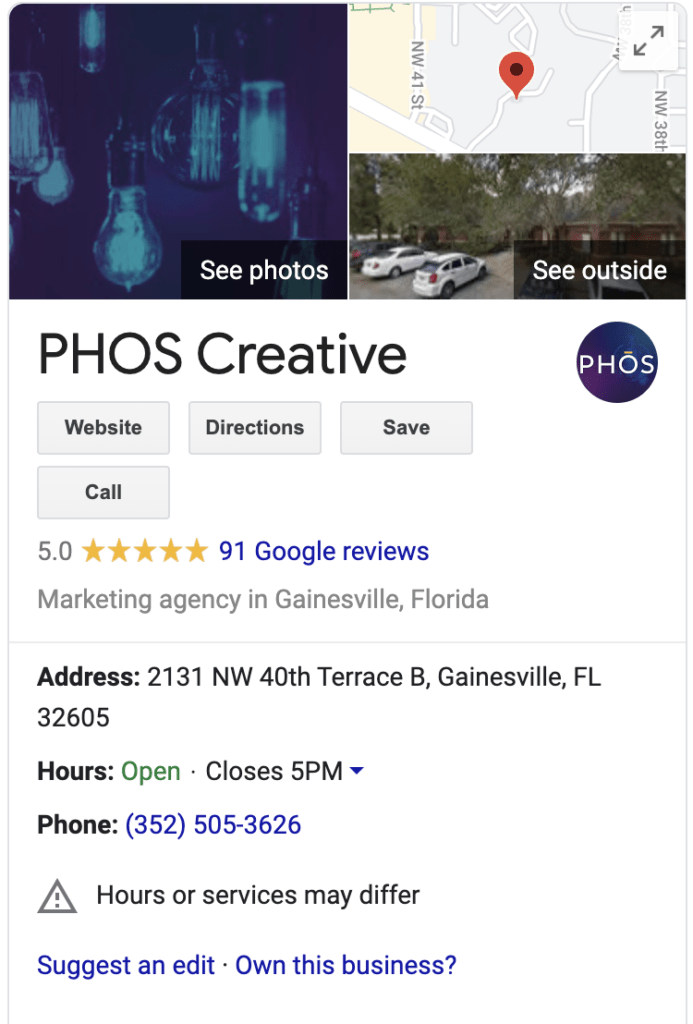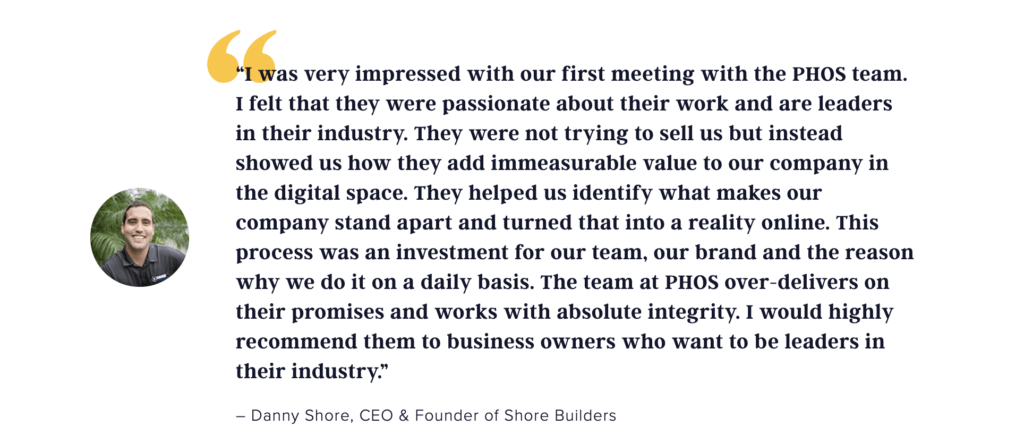As both an analyst and a creative, Jena has a penchant for crafting digital experiences for brands that delight the people they serve. She brings client visions to life through strategic planning in her role as an Inbound Marketing Executive.
April 12, 2019
Leveraging Online Customer Reviews to Drive Revenue
Opinion bears a heavyweight online. Whether it’s personal or professional, a single comment has the ability to reach hundreds, even thousands, of eyes. Social media, e-commerce websites, and search engines all feature review sections for businesses that serve as sounding boards for the thoughts, feelings, and notes people have about the products or services they use.
Platforms, like Facebook and Yelp, are designed to favor businesses associated with positive reviews, such as displaying the highly-rated businesses closer to the top of feeds and within search results. Plus, positive reviews build trust with people in your target audience who consider your brand a solution for their needs. Simply put, your bottom line will be boosted when a good review comes through.
If you’re not receiving online reviews from your customers, or if you haven’t reaped the rewards from good customer reviews, don’t assume they can’t benefit your business. In this guide, we’ll walk through where to find reviews, how to manage reviews, and ways to keep customers leaving reviews about your business online.
Identify Places Where Customers Are Talking Online
To begin collecting reviews, it’s important to establish your business on the appropriate digital platforms where customers can leave reviews.
Claim Your Business’s Google Listing
Google can answer just about any question you ask it. The leading search engine is a pillar in digital marketing, and having a presence on Google’s business listings is an essential SEO tactic for drawing traffic to your website or your other online channels.
With its specially-designed feature called Google My Business, the platform has made it possible for companies and organizations to edit the information that’s shared within the search engine and in Google Maps. The free tool enables businesses to claim their business and create an account for managing the information in the unique section that appears within search results, such as operating hours or location, and more importantly, the reviews and ratings that people leave about them on Google.
The image below is what appears on the right side of the search engine results page when people search for PHOS Creative in Google.

While it’s impossible to remove a negative review or a low rating (users can rate on a scale from 1 – 5), you have the ability to respond directly to comments left in Google Reviews as your business and those responses can be viewed by anyone who searches for your business.
To take Google My Business a step further, the search engine has launched a feature called the Google Guarantee which provides home service companies a special badge verifying their authenticity in search results to prevent against fraud. Since this is a new feature being tested in select cities, you’ll want to stay in the loop on the latest updates and information about areas where it is becoming accessible.
Monitor Your Brand on Social Media Platforms
Once you claim your business listing on Google, social media is the next area of exploration when it comes to honing your online customer review strategy. An organization’s social media accounts are typically recognized on the first page of search results when people enter a search query. Within social media platforms that allow users to leave reviews on a business’s profile, customer ratings are often highlighted at the top of a profile.
The social media platforms you may be present on tend to vary by industry. However, nearly all organizations have a Facebook page. The social media platform showcases user reviews for businesses by presenting the cumulative rating by Facebook users (ranging from 1 – 5) next to the profile image within its internal search results, and at the top of the profile page where it can be easily seen. The platform also allows users to leave written comments about their experience with a business.
In the image below, you can see that our business rating is featured next to our Facebook page profile picture whenever Facebook users search our name.

With Facebook currently being the world’s largest social platform by the number of active users (and Messenger, which is a messaging feature by Facebook, coming in fourth place), good reviews and ratings on the platform are crucial for getting more people to notice your business online and converting them into customers.
Unlike social media platforms such as Facebook, which hosts personal and professional social media users, platforms such as Yelp and Tripadvisor are designed to focus on their review forums. Both are tailored toward businesses in the service industry and cannot be ignored if your organization falls within that realm. Tripadvisor is a review hotspot for all things related to travel, such as hotels and organized tours, whereas Yelp extends its review coverage to restaurants, salons, health care, and more.
If your organization doesn’t fall into any of the categories mentioned above, there may be a niche website that is relevant to your brand. Listed below are a few other platforms where users to leave reviews about organizations in specific industries:
- Glassdoor (employers)
- Amazon Customer Reviews (products)
- Trustpilot (companies, products, and services)
- Angie’s List (home service providers)
- G2 Crowd (business solutions)
- TrustRadius (software)
Keeping a pulse with the conversations people are having on all social media platforms is important for understanding the experience your consumers are having. Positive feedback will naturally draw people to your business, while negative customer experiences can provide the learnings needed to make important readjustments for your business that can save it from making future missteps.
Quickly Respond to Positive and Negative Reviewers
Whenever a customer writes a review, it’s best practice to respond within 48 hours of it being posted. The logic behind this mindset is that a delayed response indicates a lack of attentiveness and poor customer service, which is never a favorable look to viewers in the public eye. For someone to take the time to write a review about your organization, whether it’s good or bad, it is an investment in your reputation to take a few moments to craft a response.
Reviews offer insight into what is working, and not working, for your brand. However, during cases where a customer leaves a review based on an exaggerated or false experience, providing a direct response to such comments is necessary to avoid further damaging your brand’s reputation and appeal to potential customers.
Though a negative review is not ideal, and even an uncomfortable situation to face, research indicates that people think favorably of brands that respond back to criticism.
According to research featured in the Harvard Business Review, improvements in consumer ratings have a direct correlation with responses. The analysis showed that the rate of negative reviews subsides whenever business management regularly responds to critical comments and feedback. Furthermore, the same trend occurred whenever management did the same for positive reviews.
Whether it’s good or bad news, being proactive by responding to each review can greatly impact your overall rating on platforms where your customers and target audiences are active.
Keep the Reviews Coming and Reap the Rewards
The power that reviews possess for an organization are far-reaching, and they are a foolproof opportunity for spreading awareness for your brand. Yet, a problem many businesses face is that their happiest customers won’t take the time to write a review – only the consumers who have negative experiences. When this phenomenon happens, a business can appear irresponsible and untrustworthy online, even when that’s hardly the case in reality.
Negative reviews are almost always going to happen when someone is riled up after a bad experience. Though it’s impossible to avoid receiving a bad review, what you can do is outnumber them with positive comments. Don’t be shy with encouraging your loyal customers to leave reviews after using your product or service, whether it’s verbally, in your printed marketing materials, or through a follow-up email.
Many consumers feel honored when asked to share their personal opinion, and the process of writing a review can even make them feel more connected to your brand afterward.
However, since capturing good reviews isn’t always easy, there are several platforms that have capabilities that make it easier to connect the customer with the ability to leave a review. Such tools are particularly useful for industries that have little in-person customer interactions, such as home service companies.
Here are a few platforms that are built for automating the process of collecting reviews from customers, in addition to other reputation management features:
Platforms for all industries:
Platforms for home service providers:
By implementing a manual process of collecting reviews or using software to break down the barriers of reaching customers, you’ll consistently get the positive reviews that are necessary for gaining more traction online that fuels business.
Repurposing a Review for Social Proof and Other Content
An overlooked perk of receiving good reviews are the countless content marketing opportunities that emerge. Instead of taking the time to hunt for testimonials or feedback from former customers when creating marketing materials, existing online reviews are right at your fingertips to use.
Your website, ebooks, videos, and social media posts are just a few of the many places where you can feature feedback that has been posted online by your biggest fans. Let customers provide evidence, or “social proof,” to others who are checking out your business online about what makes your product or service better than the competition.

On the PHOS website, we’ve featured a quote by a former client on Our Why page to showcase our ability to serve clients with excellence.
Research supports that authentic reviews carry more influence at grabbing the attention of consumers. In a study by Bright Local, 91% of 18-34-year-olds trust online reviews as much as personal recommendations.
Instead of telling people why they should seek your business, let others speak on your behalf because it has more impact psychologically. By referencing the positive reviews and high ratings that your business has received in your content marketing, you can effortlessly sell your business as trustworthy and excellent – all without having to spin up extra copy or creative visuals to persuade people of that.
Why a 5-Star Rating Can Seriously Scale Your Business
Online ratings and reviews can make or break your reputation. With more people using social media and search engines than ever before, receiving positive reviews and 5-star ratings are necessary if you want your brand to rise (literally) above the competition.
On the Google search results page, especially in the local pack for brick-and-mortar businesses, a higher rating means better SEO since you’ll rank higher. Also, whenever a person searches for your business on Google, any reviews are highlighted directly on the search results page. For social media, ratings and reviews are typically visible on business profile pages and within search results.
When a review is positive or a 5-star rating is received, it may be what convinces a potential customer into purchasing your product or service, which increases your bottom line. By applying the advice covered throughout this article, you can even overcome negative reviews and turn them into future business opportunities.
The team at PHOS is passionate about using technology for brands to manage their online reputation. If you want to learn more about how we help companies emerge as trusted solutions within their industries, take a look at the digital marketing services we offer.







